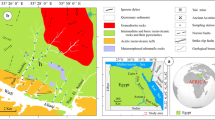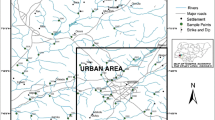Abstract
The purposes of this study were to assess the influence of old mining activities on the geochemistry and quality of sediments and to identify the sites of economic elements. Thirty sites of stream sediment were sampled in the study area covered by granitic, metarhyodacitic and meta-andesitic rocks and related tuffs-hosted abandoned Au mine. The suite of chemical elements, Ag, Bi, Cd, Cu, Fe, Ga, Hg, Mn, Nb, Pb, Rb, Sb, Se, Sn, Te, Th, U, Y, Zn and Zr, pH value and total organic carbon were determined, and univariate, bivariate and multivariate statistical methods were applied. The results show that the enrichment factor (EF) is very high in the case of Te and significant also with respect to Ag, Bi, Cu, Sb, Se, Sn and Zn. Likewise, geoaccumulation indices (Igeos) varied from very highly polluted with Sn and Te, strongly to very strongly polluted with Bi and Se, and moderately polluted with Sb. The polluted sites of Ag, Bi, Sb, Se, Sn and Te were outlined using Igeos maps, and economic sites of Ag and Sn were identified by geochemical maps leading to their sources, which are likely to be mining activities and lithogenic processes. The pollutant elements may cause toxicity in stream sediments, or surface or underground water, as well as plants and animals in the area. This investigation provides an environmental baseline for future monitoring of possible human/anthropogenic, industrial and agricultural impacts on the study area and considers an attempt at re-mining Ag and Sn.






Similar content being viewed by others
References
Ávila PF, Oliveira JMS, Ferreira da Silva E, Fonseca EC (2005) Geochemical signatures and mechanisms of trace elements dispersion in the area of the Vale das Gatas mine (Northern Portugal). J Geochem Explor 85:17–29
Beus AA, Grigorian SV (1977) Geo-chemical exploration methods for mineral deposits. Applied Pub. Co., Willmette, p 278
Chapman D (1996) Water quality assessments. A guide to the use of biota, sediments and water in environmental monitoring. Chapman & Hall, London
Chen TB, Zheng YM, Lei M, Huang ZCh, Wu HT, Chen H, Fan KK, Yu K, Wu X, Tian QZ (2005) Assessment of heavy metal pollution in surface soils of urban parks in Beijing, China. Chemosphere 60:542–551
Cheng Q, Agterberg FP, Bonham-Carter GF (1996) A spatial analysis method for geochemical anomaly separation. J Geochem Explor 56:183–195
Chester R, Stoner JH (1973) Pb in particulates from the lower atmosphere of the eastern Atlantic. Nature 245:27–28
Davis JA, Leckie JO (1978) Effect of adsorbed complexing ligands on trace metal uptake by hydrous oxides. Environ Sci Technol 12:1309–1315
EGSMA (1996) Geologic map of Wadi Jabjabah quadrangle, Egypt. Geol. Surv., Cairo, Egypt
Einax JW, Soldt U (1998) Geostatistical and multivariate statistical methods for the assessment of polluted soils—merits and limitations. Chemom Intell Lab Syst 46:79–91
El-Sabagh MEI (2001) Geological study of Pan-African rocks between Wadi Neqiet and Wadi Marahiq, Allaqi are, South Eastern Desert, Egypt. M.Sc. thesis. Ain Shams Uni
Facchinelli A, Sacchi E, Mallen L (2001) Multivariate statistical and GIS based approach to identify heavy metal sources in soils. Environ Pollut 114:313–324
Ferguson C, Kasamas H (1999) Risk assessment for contaminated sites in Europe. Policy framework, vol 2. LQM Press, Nottingham
Gaebler H (1997) Mobility of heavy metals as a function of pH of samples from an overbank sediment profile contaminated by mining activities. J Geochem Explor 58:185–194
García R, Maiz I, Millán E (1996) Heavy metal contamination analysis of road soils and grasses from Guipúzkoa (Spain). Environ Technol 17:763–770
Garrett RG (1989) A cry from the heart. Explore (AEG Newsl.) 66:18–20
Govett GJS, Goodfellow WD, Chapman A, Chork CY (1975) Exploration geochemistry distribution of elements and recognition of anomalies. Math Geol 7:415–446
Grosbois C, Courtin-Nomade A, Martin F, Bril H (2007) Transportation and evolution of trace element bearing phases in stream sediments in a mining-influenced basin (Upper Isle River, France). Appl Geochem 22:2362–2374
Horowitz AJ (1991) A primer on sediment–trace element chemistry. Lewis Publishers, Chelsea
Jordan C, Zhang C, Higgins A (2007) Using GIS and statistics to study influences of geology on probability features of surface soil geochemistry in Northern Ireland. J Geochem Explor 93:135–152
Ketterer ME, Lowry JH, Simon J Jr, Humphries K, Mark P, Novotnak MP (2001) Lead isotopic and chalcophile element compositions in the environment near a zinc smelting ± secondary zinc recovery facility, Palmerton, Pennsylvania, USA. Appl Geochem 16:207–229
Kralik M (1999) A rapid procedure for environmental sampling and evaluation of polluted sediments. Appl Geochem 14:807–816
Kusky TM, Ramadan TM (2002) Structural controls on Neoproterozoic mineralization in the South Eastern Desert, Egypt: an integrated field, Landsat TM, and SIR-C/X SAR approach. J Afr Earth Sci 35:107–121
Martínez J, Llamas J, de Miguel E, Rey J, Hidalgo MC (2007) Determination of the geochemical background in a metal mining site: example of the mining district of Linares (South Spain). J Geochem Explor 94:19–29
Miesch AT (1981) Estimation of the geochemical threshold and its statistical significance. J Geochem Explor 16:49–76
Moghazy NM, Emam AA, Abdel Rahman EM (2009) Mineral chemistry and geochemical aspects of Gebel Filat granites, South Eastern Desert, Egypt. Arab J Geosci. doi:10.1007/s12517-009-0073-x
Müller G (1979) Schwermetalle in den Sedimenten des Rheines-Vera¨nderungen seit 1971. Umschau 79:778–785
Müller G (1981) Die Schwermetallbelastung der Sedimente des Neckars und seiner Nebenflusse: eine Bestandsaufnahme. Chem Zeitung 105:157–164
Naseem S, Sheikh SA, Qadeeruddin M, Shirin K (2002) Geochemical stream sediment survey in Winder Valley, Balochistan, Pakistan. J Geochem Explor 76:1–12
Neaman A, Mouèlè F, Trolard F, Bourriè G (2004) Improved methods for selective dissolution of Mn oxides: applications for studying trace element associations. Appl Geochem 19:973–979
Nriagu JO (1990) Global metal pollution poisoning the biosphere? Environment 32:7–33
Nriagu JO, Pacyna JM (1988) Quantitative assessment of world-wide contamination of air water and soils by trace metals. Nature 333:47–49
Ohta A, Imai N, Terashima S, Tachibana Y, Ikehara K, Nakajima T (2004a) Geochemical mapping in Hokuriku, Japan: Influence of surface geology, mineral occurrences and mass movement from terrestrial to marine environments. Appl Geochem 19:1453–1469
Ohta A, Imai N, Terashima S, Tachibana Y (2004b) Investigation of elemental behaviors in Chugoku region of Japan based on geochemical map utilizing stream sediments. Chikyukagaku (Geochemistry) 38:203–222 in Japanese, with English abstract
Ohta A, Imai N, Terashima S, Tachibana Y (2005) Application of multi-element statistical analysis for regional geochemical mapping in Central Japan. Appl Geochem 20:1017–1037
Ohta A, Imai N, Terashima S, Tachibana Y, Ikehara K, Okai T, Ujiie-Mikoshiba M, Kubota R (2007) Elemental distribution of coastal sea and stream sediments in the island-arc region of Japan and mass transfer processes from terrestrial to marine environments. Appl Geochem 22:2872–2891
Peng B, Song Z, Tu X, Xiao M, Wu F, Lv H (2004) Release of heavy metals during weathering of the Lower Cambrian Black Shales in western Hunan. Chin Environ Geol 45:1137–1147
Peng B, Piestrzynski A, Pieczonka J, Xiao M, Wang Y, Xie S, Tang X, Yu C, Song Z (2007) Mineralogical and geochemical constraints on environmental impacts from waste rock at Taojiang Mn-ore deposit, central Hunan. Chin Environ Geol 52:1277–1296
Ramadan TM, Abdelsalam MG, Stem RJ (2001) Mapping gold-bearing massive sulfide deposits in the Neoproterozoic allaqi suture, Southeast Egypt with Landsat TM and SIR = C/X SAR images. Photogramm Eng Remote Sensing 67(4):491–497
Rantitsch G (2000) Application of fuzzy clusters to quantify lithological background concentrations in stream-sediment geochemistry. J Geochem Explor 71:73–82
Rantitsch G (2001) The fractal properties of geochemical landscapes as an indicator of weathering and transport processes within the Eastern Alps. J Geochem Explor 73:27–42
Rantitsch G (2004) Geochemical exploration in a mountainous area by statistical modeling of polypopulational data distributions. J Geochem Explor 82:79–95
Ratha DS, Sahu BK (1993) Source and distribution of metals in urban soils of Bombay, India, using multivariate statistical techniques. Environ Geol 22:276–285
Reimann C, de Caritat P (2005) Distinguishing between natural and anthropogenic sources for elements in the environment: regional geochemical surveys versus enrichment factors. Sci Tot Environ 337:91–107
Reimann C, Filzmoser P (2000) Normal and lognormal data distribution in geochemistry: death of a myth. Consequences for the statistical treatment of geochemical and environmental data. Environ Geol 39:1001–1014
Reimann C, Filzmoser P, Garrett RG (2002) Factor analysis applied to regional geochemical data: problems and possibilities. Appl Geochem 17:185–206
Reimann C, Arnoldussen A, Englmaier P, Filzmoser P, Finne TO, Garrett RG, Koller F, Nordgulen Ø (2007) Element concentrations and variations along a 120-km transect in southern Norway—anthropogenic vs. geogenic vs. biogenic element sources and cycles. Appl Geochem 22:851–871
Reith F, McPhaila DC, Christya AG (2005) Bacillus cereus, gold and associated elements in soil and other regolith samples from Tomakin Park Gold Mine in southeastern New South Wales, Australia. J Geochem Explor 85:81–98
Roychoudhury AN, Starke MF (2006) Partitioning and mobility of trace metals in the Blesbokspruit: impact assessment of dewatering of mine waters in the East Rand, South Africa. Appl Geochem 21:1044–1063
Ruiz F (2001) Trace metals in estuarine sediments from the southwestern Spanish Coast. Mar Pollut Bull 42:482–490
Saleh GM, Makroum FM (2003) Pan-African magmatism: geochemical evolution and uranium mineralization of granitoid rocks, Southeastern Desert, Egypt. J Int Geol Rev 45(2):157–175
Salonen V, Korkka-Niemi K (2007) Influence of parent sediments on the concentration of heavy metals in urban and suburban soils in Turku, Finland. Appl Geochem 22:906–918
Shaw DM (1961) Element distribution laws in geochemistry. Geochim Cosmochim Acta 23:116–134
Sinclair AJ (1974) Selection of thresholds in geochemical data using probability graphs. J Geochem Explor 3:129–149
Sinclair AJ (1976) Application of probability graphs in mineral exploration. Assoc Explor Geochem Spec 4:95
Sinclair AJ (1991) A fundamental approach to threshold estimation in exploration geochemistry: probability plots revisited. J Geochem Explor 41:1–22
Singh M, Müller G, Singh IB (2003) Geogenic distribution and baseline concentration of heavy metals in sediments of the Ganges River. Indian J Geochem Explor 80:1–17
Standring WJF, Oughton DH, Salbu B (2002) Remobilization of 109Cd, 65Zn and 54Mn from freshwater-labelled river sediments when mixed with freshwater. Environ Int 28:185–195
Stanley CR (1988) Comparison of data classification procedures in applied geochemistry using Monte Carlo simulation. Unpublished Ph.D. Thesis, University of British Columbia, Vancouver, p 256
Stanley CR, Sinclair AJ (1989) Comparison of probability plots and gap statistics in the selection of threshold for exploration geochemistry data. J Geochem Explor 32:355–357
van Helvoort PJ, Filzmoser P, van Gaans PFM (2005) Sequential factor analysis as a new approach to multivariate analysis of heterogeneous geochemical datasets: an application to a bulk chemical characterization of fluvial deposits (Rhine–Meuse delta, The Netherlands). Appl Geochem 20:2233–2251
Yilmaz H (2003) Geochemical exploration for gold in western Turkey: success and failure. J Geochem Explor 80:117–135
Zhang C, Manheim FT, Hinde J, Grossman JN (2005) Statistical characterization of a large geochemical database and effect of sample size. Appl Geochem 20:1857–1874
Acknowledgements
I express my gratitude to Prof. Dr. Dr. Herbert Poelmann for his assistance in the geochemical analysis during my work at Institute of geosciences, Faculty of natural sciences III, Halle university, Germany. Mr. Abdel Karim A.G. Darwish is thanked for his help in sampling during the field work.
Author information
Authors and Affiliations
Corresponding author
Rights and permissions
About this article
Cite this article
Darwish, M.A.G. Geochemical reconnaissance survey and environmental assessment for stream sediments of Wadi Um Gier, Southeastern Desert, Egypt. Environ Earth Sci 62, 657–672 (2011). https://doi.org/10.1007/s12665-010-0555-x
Received:
Accepted:
Published:
Issue Date:
DOI: https://doi.org/10.1007/s12665-010-0555-x




